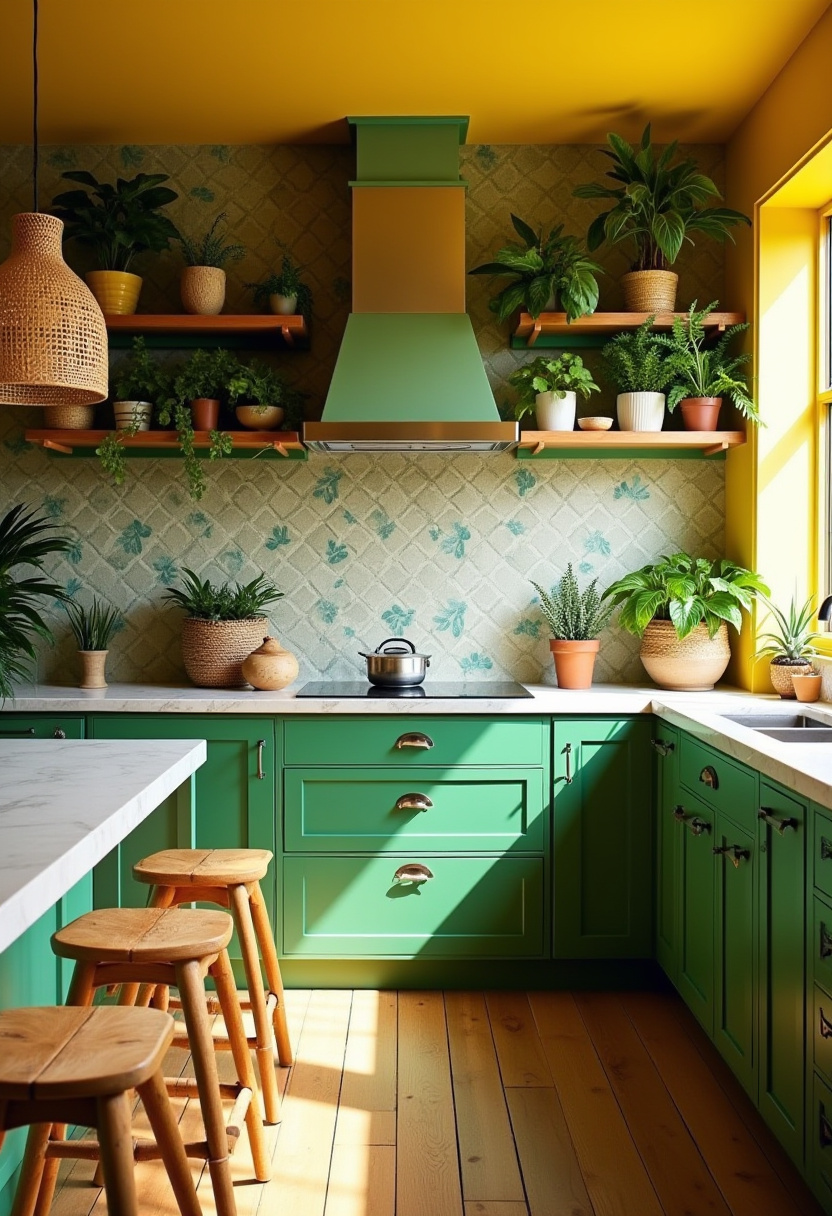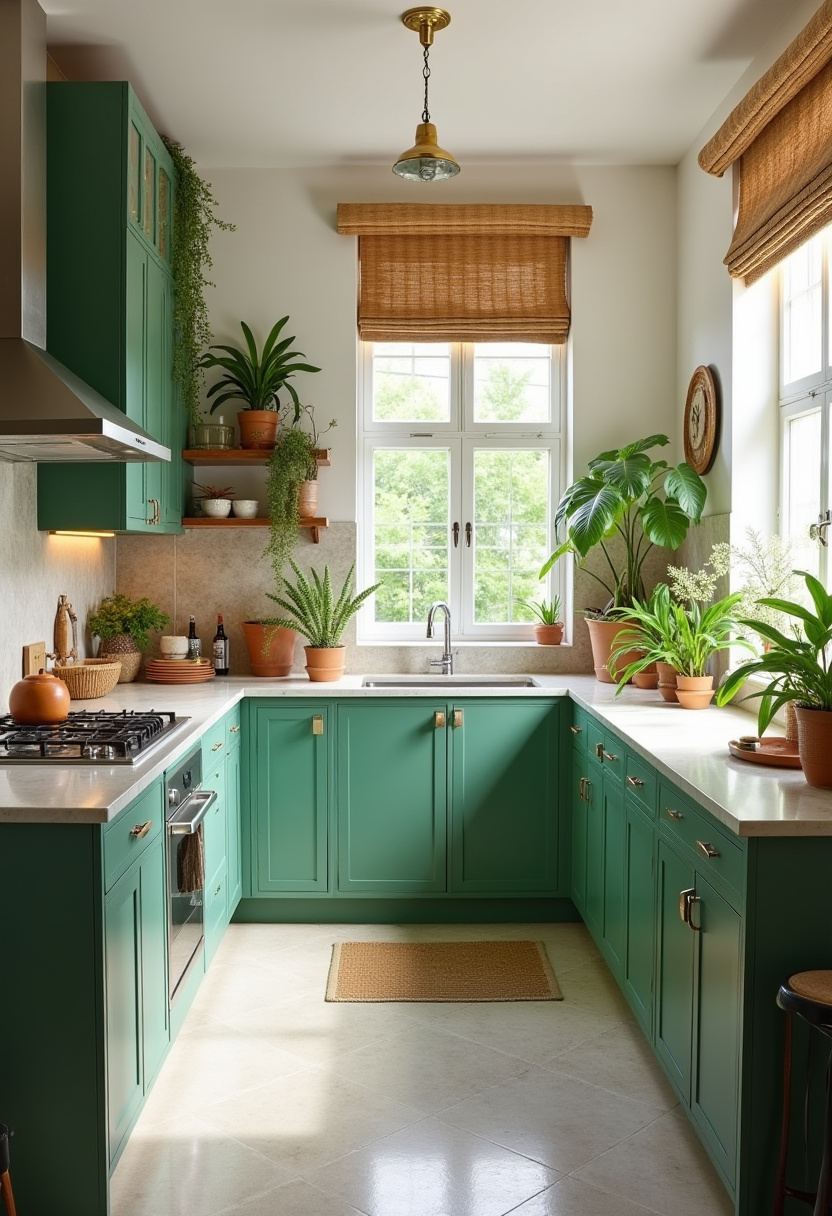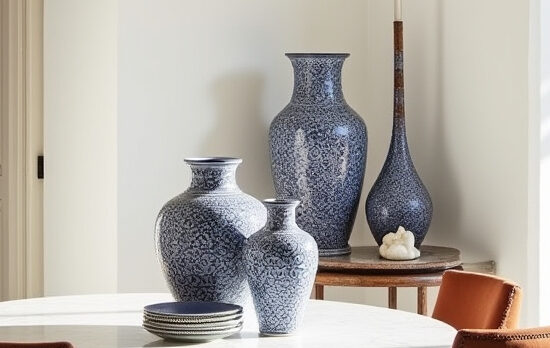In the world of interior design, the wabi sabi philosophy offers a refreshing perspective that celebrates the beauty in imperfection and transience. This Japanese aesthetic encourages us to find harmony in the natural world, showcasing a sense of authenticity that resonates deeply with our desire for meaningful spaces.
The kitchen, often considered the heart of the home, is a perfect canvas for this philosophy, allowing for the integration of natural materials, organic forms, and a serene atmosphere that encourages connection and creativity.
The wabi sabi kitchen embraces various design aspects, from rustic charm to minimalist elegance, each catering to different lifestyles and preferences. In this article, we will explore 30 unique wabi sabi kitchen concepts that incorporate diverse styles, materials, and color palettes, emphasizing the art of balance and simplicity.
Each concept aims to inspire you to create a kitchen that reflects your personality while inviting a sense of calm and tranquility into your home.
1. Urban Jungle Serenity
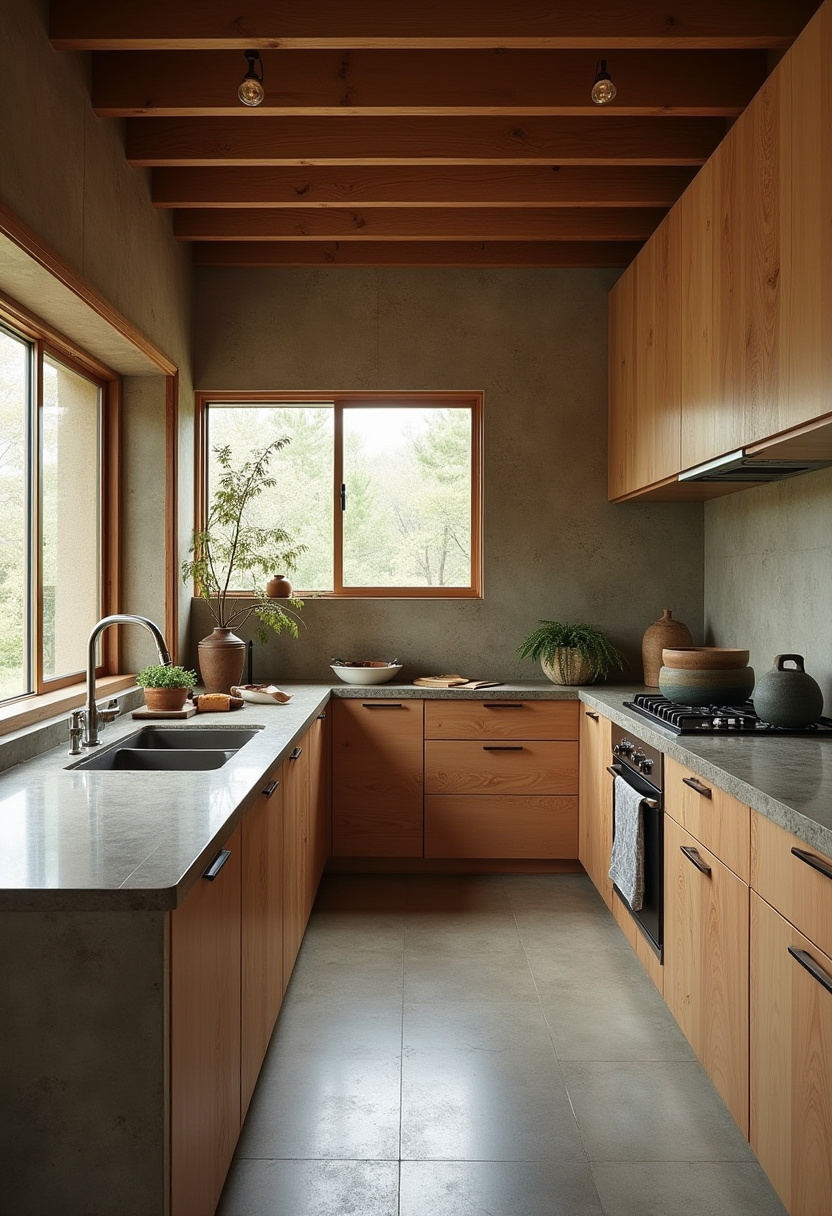
Picture a kitchen where reclaimed wood cabinetry harmonizes with the lushness of an urban jungle palette. This wabi sabi kitchen embodies Japanese Zen style, with handmade pottery adorning the open shelves, inviting warmth and character.
The stone countertops, with their natural imperfections, become a canvas for culinary creativity, while soft, natural lighting filters through rice paper screens, casting gentle shadows that dance on the surfaces. Weathered textural elements, inspired by the works of Tadao Ando, contribute to an atmosphere of tranquility and mindfulness.
The interplay of textures in this kitchen creates depth and interest. From the smoothness of the stone countertops to the roughness of the reclaimed wood, each element tells a story of its own.
The overall mood is one of peace, encouraging gatherings filled with laughter and shared meals. This space is a true sanctuary for culinary exploration.
- Incorporate reclaimed wood to add history and warmth.
- Opt for handmade ceramics to showcase craftsmanship.
- Use soft lighting to create an inviting atmosphere.
- Integrate plants to enhance the connection with nature.
2. Minimalist Nordic Retreat

This wabi sabi kitchen embraces minimalist style with a palette of nordic neutrals that evoke calm and simplicity. Imperfect ceramic tiles add character to the backsplash, while wooden cutting boards and aged copper cookware serve as functional art.
Dappled sunlight creates organic shadows, highlighting the asymmetrical design elements that make this space unique. Influenced by the designs of Vincent Van Duysen, this kitchen captures the essence of serene living.
In this minimalist retreat, every piece has a purpose, contributing to a cohesive whole that feels both intentional and relaxed. The muted color scheme fosters a sense of clarity, allowing the mind to unwind and focus on the joy of cooking.
This kitchen is a testament to the beauty of less—a space where simplicity reigns supreme.
- Choose a neutral color palette for a calming effect.
- Embrace imperfections in ceramic tiles for added character.
- Incorporate functional decor items, like wooden boards and cookware.
- Allow natural light to play a role in creating ambiance.
3. Rustic Earthy Elegance
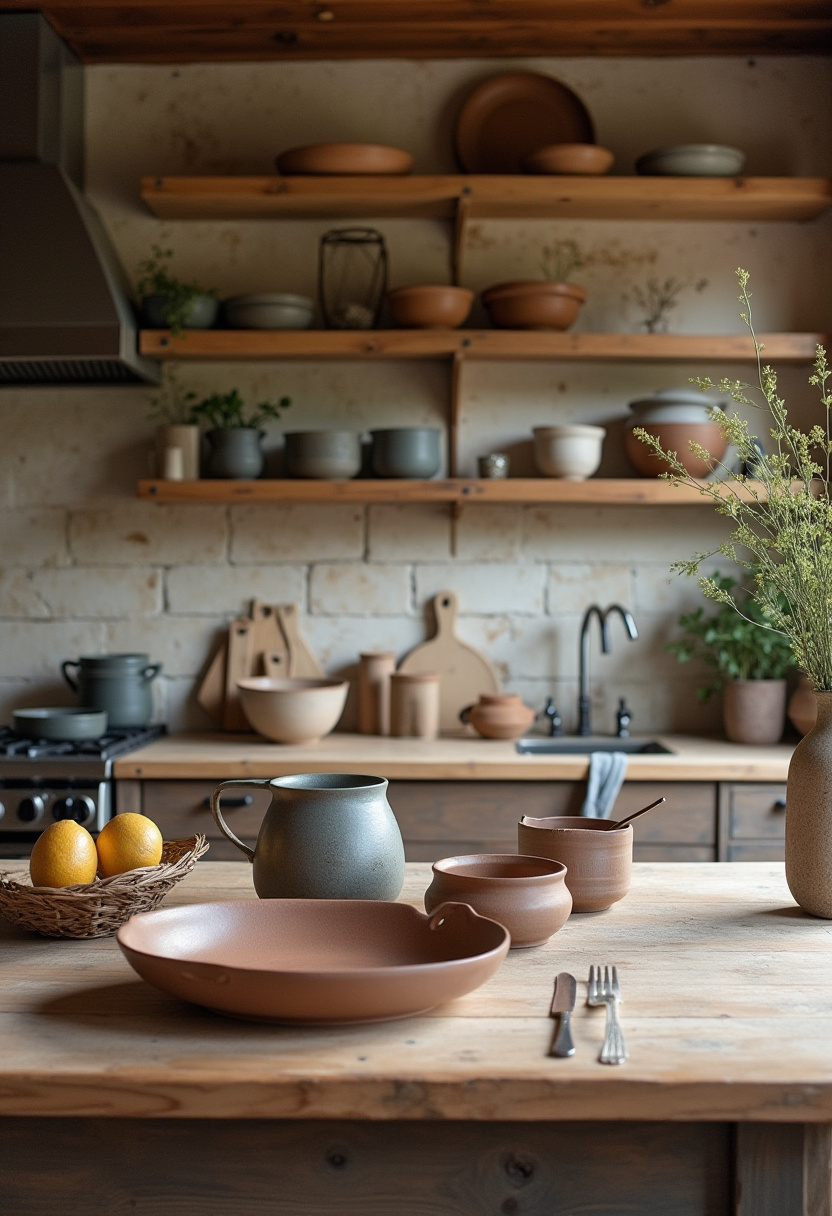
In this wabi sabi kitchen, rustic charm meets earthy elegance, showcasing hand-thrown clay dishware and distressed wooden surfaces that exude warmth and authenticity. The natural stone backsplash, with its rich textures, acts as a stunning focal point, while warm ambient lighting highlights the kitchen’s textural imperfections, creating an inviting glow.
Inspired by Justina Blakeney’s designs, this space feels like a cozy retreat from the outside world.
The combination of handcrafted elements and natural materials establishes a welcoming environment that encourages creativity and connection. This kitchen is not just a place for cooking; it’s a haven for gathering, where the beauty of imperfection is celebrated.
The earthy tones and textures foster a sense of comfort, making it the perfect backdrop for shared meals and heartfelt conversations.
- Use hand-thrown ceramics to add a personal touch.
- Incorporate natural stone for a striking visual element.
- Layer warm lighting to enhance the cozy atmosphere.
- Choose distressed wood for character and authenticity.
4. Industrial Chic Fusion

This wabi sabi kitchen embraces industrial chic style, where charcoal and wood tones create a dramatic yet inviting atmosphere. Exposed concrete walls provide an urban edge, while salvaged wooden shelving adds warmth and rustic charm.
Patinated metal fixtures contribute to the overall aesthetic, allowing the space to feel both modern and timeless. Soft morning light filters through the windows, creating gentle shadows that soften the starkness of the industrial elements, as envisioned by Kelly Wearstler.
The contrast of materials in this kitchen creates a dynamic interplay that captures the essence of urban living. The combination of hard and soft elements invites a sense of balance and harmony, making it a space where creativity can flourish.
The overall mood is one of stylish sophistication, perfect for those who appreciate the beauty of raw materials.
- Incorporate exposed concrete for an industrial vibe.
- Add salvaged wood to soften the space.
- Use patinated metal fixtures as statement pieces.
- Emphasize natural light to create a welcoming atmosphere.
5. Scandinavian Minimalism
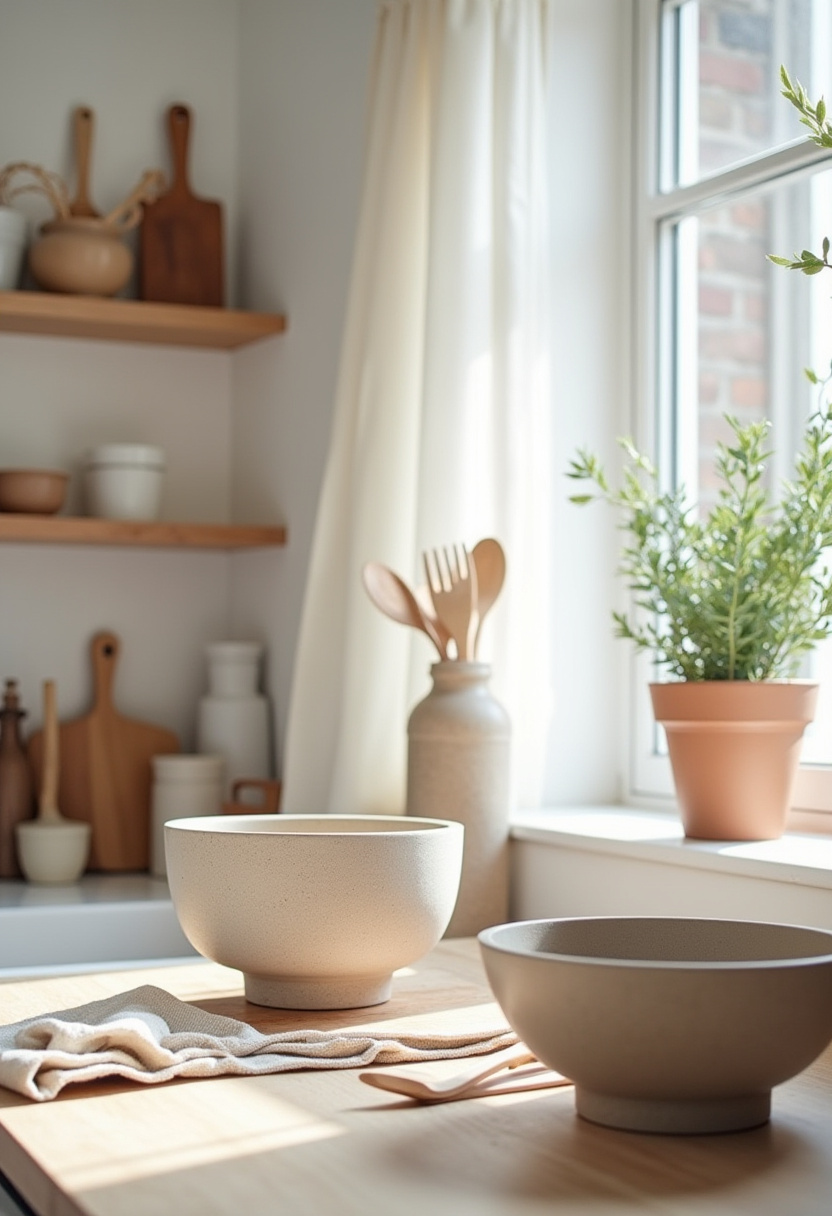
This wabi sabi kitchen showcases Scandinavian style through a palette of nordic neutrals, featuring hand-carved wooden utensils and minimalist ceramic bowls. Natural linen textiles add softness to the design, while gentle sunlight streams through large windows, creating an organic asymmetrical layout inspired by Piet Mondrian.
The simplicity of this space is both calming and inviting, encouraging a connection to nature.
In this kitchen, every element serves a purpose, reflecting the principles of minimalism and functionality. The soft textures and muted colors foster a serene atmosphere, allowing for moments of reflection and creativity.
This space is ideal for those who appreciate simplicity and the beauty of natural materials.
- Utilize a neutral color palette for a tranquil effect.
- Opt for handmade wooden utensils for authenticity.
- Incorporate linen textiles for softness and warmth.
- Maximize natural light for an airy feel.
6. Biophilic Harmony
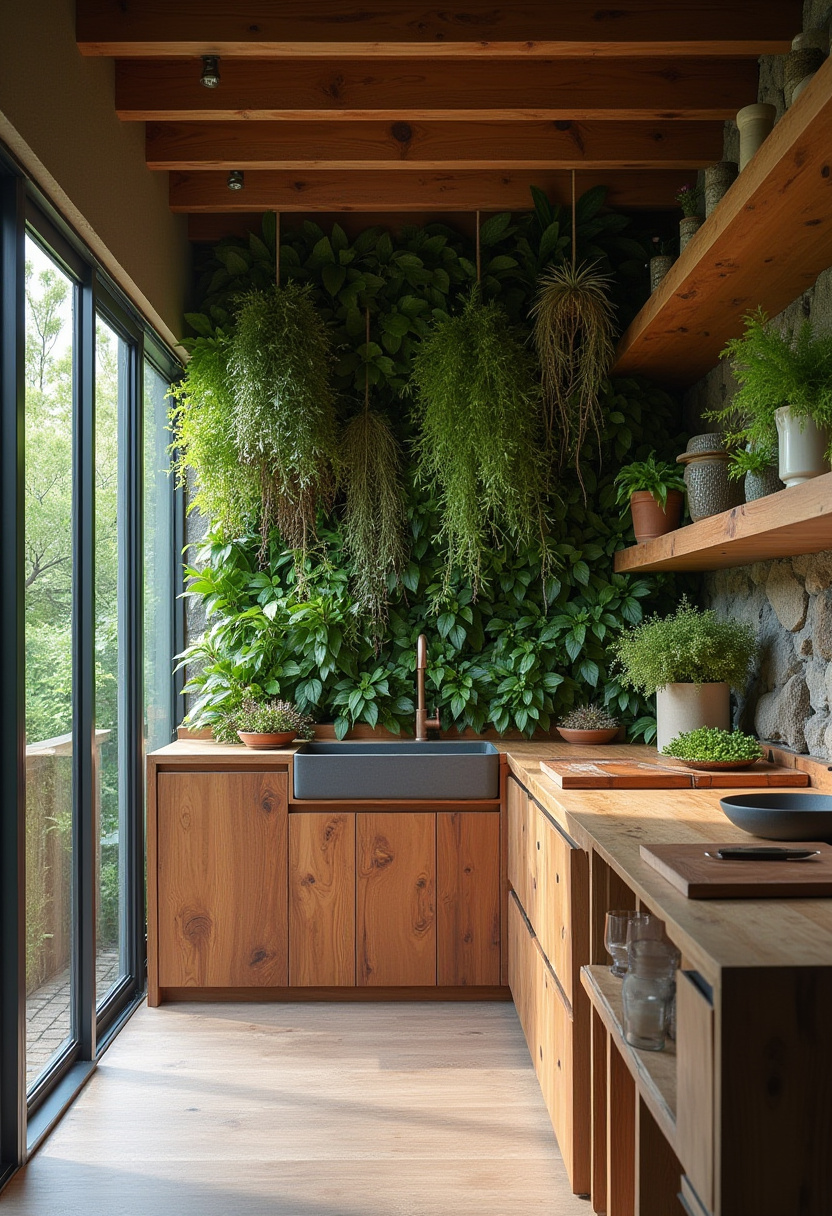
Step into a biophilic kitchen that celebrates the beauty of nature with an urban jungle palette. Featuring a living herb wall and recycled wood countertops, this space embodies the principles of sustainability and wellness.
A handcrafted ceramic sink serves as a functional centerpiece, while natural light filters through the hanging plants, creating a serene atmosphere inspired by Renzo Piano.
This kitchen is a testament to the connection between indoor and outdoor spaces, fostering a sense of tranquility and inspiration. The vibrant greens of the herb wall infuse the area with life, encouraging culinary creativity and healthy living.
This space is perfect for those who seek to incorporate nature into their daily routines.
- Add a living herb wall for freshness and utility.
- Choose recycled materials for a sustainable approach.
- Incorporate plants for a natural feel and improved air quality.
- Utilize natural light to enhance the connection with nature.
7. Coastal Serenity

This wabi sabi kitchen channels coastal style with soft blues and sandy beiges that evoke the tranquility of the ocean. Driftwood elements and hand-glazed ceramic tiles create a harmonious blend of textures, while weathered maritime accessories add character and charm.
Diffused natural light pours in from large windows, filling the space with a warm glow, inspired by the designs of India Mahdavi.
The soothing color palette and organic forms in this kitchen create a serene atmosphere, reminiscent of beachside living. This space invites relaxation and creativity, making it perfect for culinary exploration and gatherings with loved ones.
The overall mood is one of effortless elegance, allowing for a seamless transition between indoor and outdoor living.
- Incorporate driftwood for a coastal touch.
- Use hand-glazed tiles for unique visual interest.
- Add maritime accessories for character and charm.
- Maximize natural light for an airy, open feel.
8. Traditional Japanese Essence
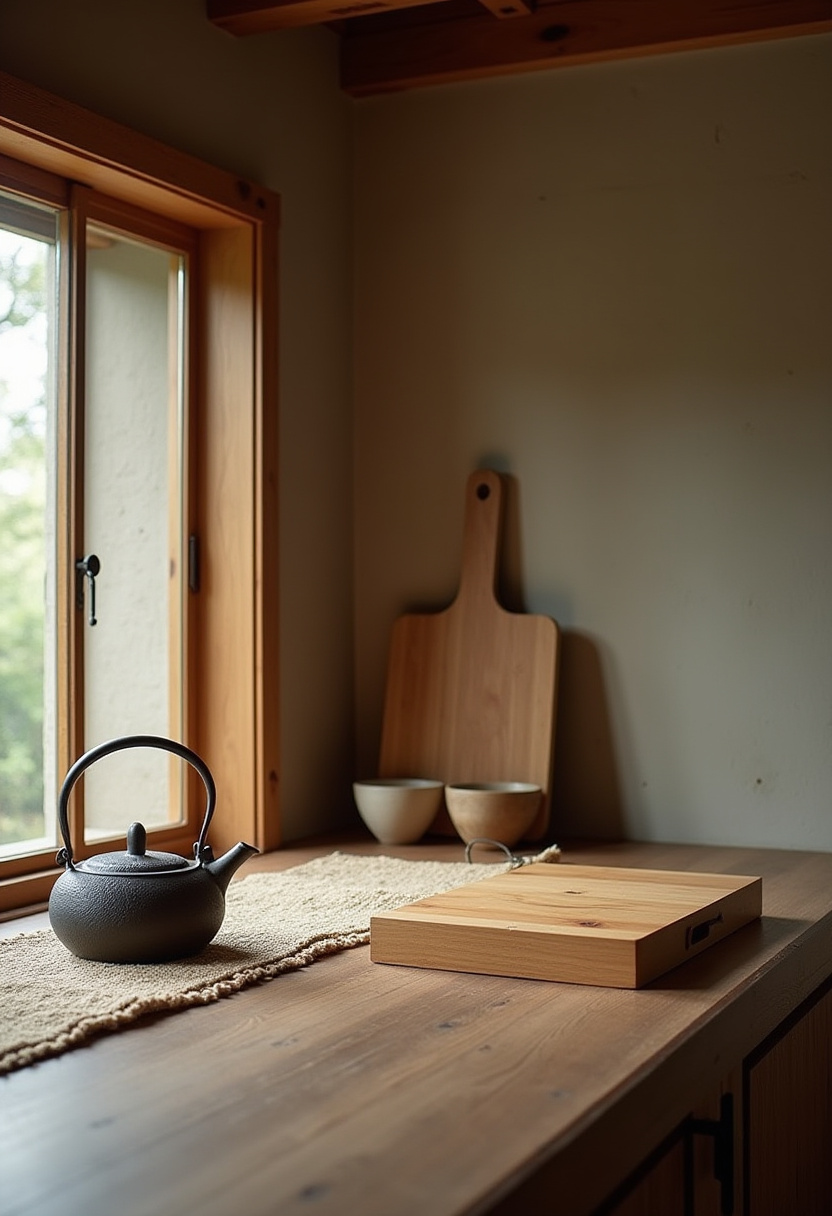
This wabi sabi kitchen pays homage to traditional Japanese design, showcasing muted earth tones and natural materials. Bamboo cutting boards and an antique cast iron tea kettle add authenticity, while hand-woven textile runners introduce warmth and texture.
Soft morning light creates gentle highlights, emphasizing the beauty of simplicity as envisioned by Tadao Ando.
The balance of materials in this kitchen fosters a sense of tranquility, allowing the space to breathe with life and purpose. This area encourages mindful cooking and dining, where each meal becomes a celebration of nature and craftsmanship.
The overall atmosphere is one of quiet elegance, ideal for those seeking a peaceful retreat.
- Use bamboo elements for a touch of nature.
- Incorporate antique pieces for authenticity and history.
- Add hand-woven textiles for warmth and comfort.
- Emphasize soft lighting to create an inviting ambiance.
9. Monochrome Brutalism
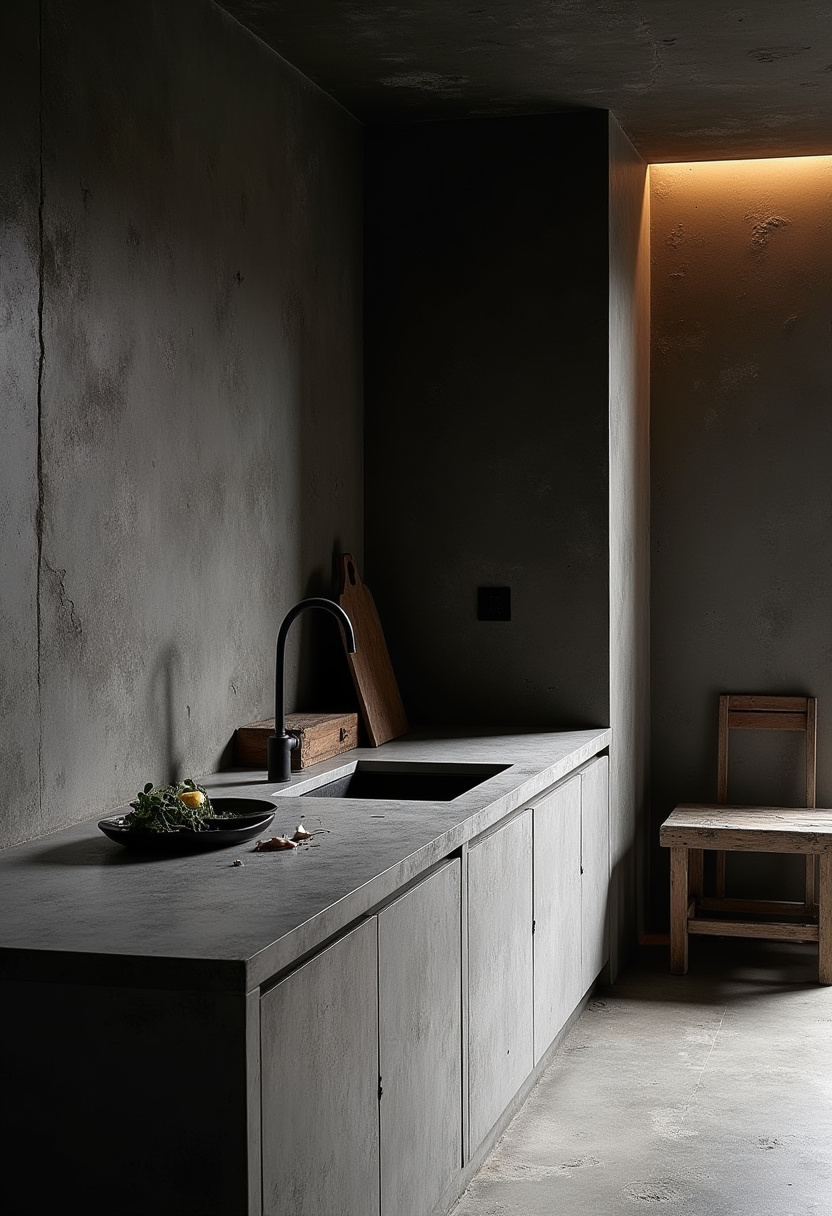
Step into a wabi sabi kitchen that challenges conventions with a brutalist style defined by a monochrome noir palette. Raw concrete surfaces and hand-carved wooden elements create a striking contrast, while aged metal fixtures add a layer of sophistication.
Dramatic side lighting emphasizes the textures, creating an atmosphere that is both bold and inviting, inspired by Le Corbusier.
This kitchen is a celebration of raw beauty, where every element plays a role in crafting a unique identity. The interplay of light and shadow creates a dynamic environment that inspires creativity and innovation.
This space is perfect for those who appreciate the beauty of industrial design intertwined with warmth and comfort.
- Utilize raw concrete for a bold, modern aesthetic.
- Incorporate hand-carved wooden elements for warmth.
- Add aged metal fixtures for sophistication and character.
- Use dramatic lighting to highlight textures and create mood.
10. Mediterranean Charm

This wabi sabi kitchen captures the essence of Mediterranean style with its terracotta and azure palette. Hand-painted ceramic tiles and weathered wooden beams create a warm and inviting atmosphere, while copper cookware adds a touch of elegance.
Warm golden hour lighting fills the space, enhancing the rustic charm and creating a cozy ambiance, inspired by Jean-Louis Deniot.
The rich color palette and handcrafted elements in this kitchen evoke a sense of warmth and hospitality, making it the perfect gathering spot for family and friends. This space encourages culinary exploration and shared moments, celebrating the joy of cooking and dining together.
The overall mood is one of effortless charm, inviting you to linger and enjoy.
- Incorporate hand-painted tiles for visual interest.
- Add weathered wooden beams for rustic charm.
- Choose copper accents for a touch of elegance.
- Utilize warm lighting to enhance the inviting atmosphere.
11. Craftsman Retreat

This wabi sabi kitchen embraces craftsman style with a rustic retreat palette, featuring a hand-hammered copper sink that serves as a stunning centerpiece. Reclaimed oak cabinetry offers warmth and character, while artisan ceramic tiles add visual interest.
Soft natural light filters through stained glass, creating a magical ambiance, inspired by Frank Lloyd Wright.
The attention to detail in this kitchen reflects the beauty of craftsmanship, where each element is thoughtfully curated to create a harmonious whole. The inviting atmosphere encourages creativity and connection, making it a welcoming space for culinary adventures and gatherings.
This kitchen embodies the spirit of craftsmanship, celebrating the artistry of the everyday.
- Use hand-hammered metals for unique focal points.
- Incorporate reclaimed wood for warmth and history.
- Add artisan tiles for visual interest and character.
- Utilize stained glass to enhance natural light and ambiance.
12. Nordic Inspired Sanctuary
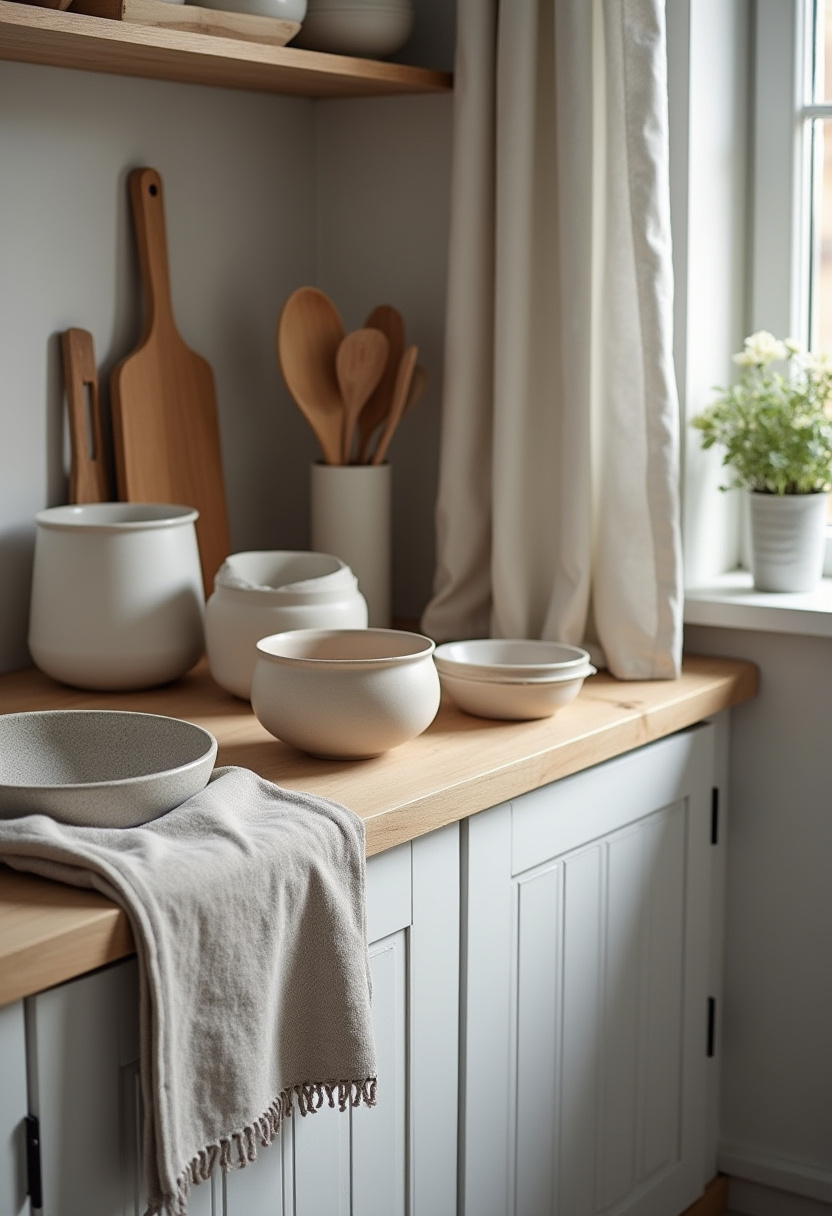
This wabi sabi kitchen reflects Nordic style through soft grays and natural woods, showcasing hand-carved wooden utensils and minimalist ceramic bowls. Linen textiles add softness, while gentle morning light pours in, creating a soothing atmosphere inspired by Vincent Van Duysen.
The simplicity of this space fosters a sense of calm and clarity, allowing for moments of tranquility amidst the bustle of daily life.
In this kitchen, every detail contributes to a cohesive and serene environment. The muted color palette and organic forms invite relaxation and creativity, making it a perfect retreat for culinary exploration.
This space embodies the essence of Scandinavian design, where functionality meets beauty in a harmonious balance.
- Utilize soft gray tones for a calming environment.
- Incorporate hand-carved wooden utensils for authenticity.
- Add minimalist ceramic bowls for a clean aesthetic.
- Emphasize natural light for an airy feel.
13. Tropical Oasis
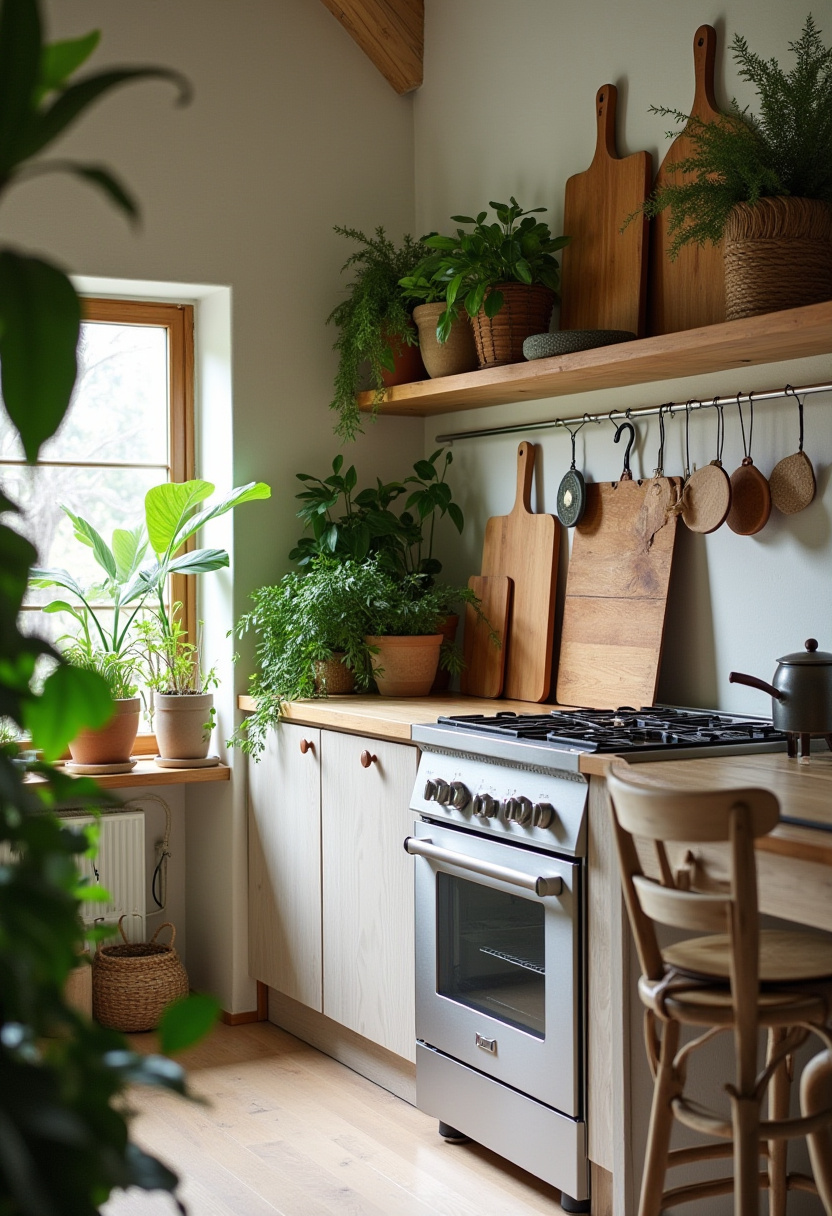
Transport yourself to a tropical paradise with this wabi sabi kitchen, featuring an urban jungle palette that invites the beauty of nature indoors. Hand-thrown ceramic plates and bamboo cutting boards create a harmonious blend of materials, while a living herb wall adds freshness and vitality.
Soft diffused light filters through the tropical plants, creating a serene atmosphere inspired by Justina Blakeney.
This kitchen is a celebration of vibrant colors and natural textures, fostering a sense of connection to the outdoors. The lush greenery and handcrafted elements encourage culinary creativity and healthy living, making it an ideal space for culinary exploration.
The overall mood is one of vitality and inspiration, inviting you to embrace the beauty of nature in your daily routine.
- Incorporate a living herb wall for freshness and utility.
- Use hand-thrown ceramics for a personal touch.
- Add bamboo elements for a tropical vibe.
- Utilize soft lighting to create a serene atmosphere.
14. Industrial Charm
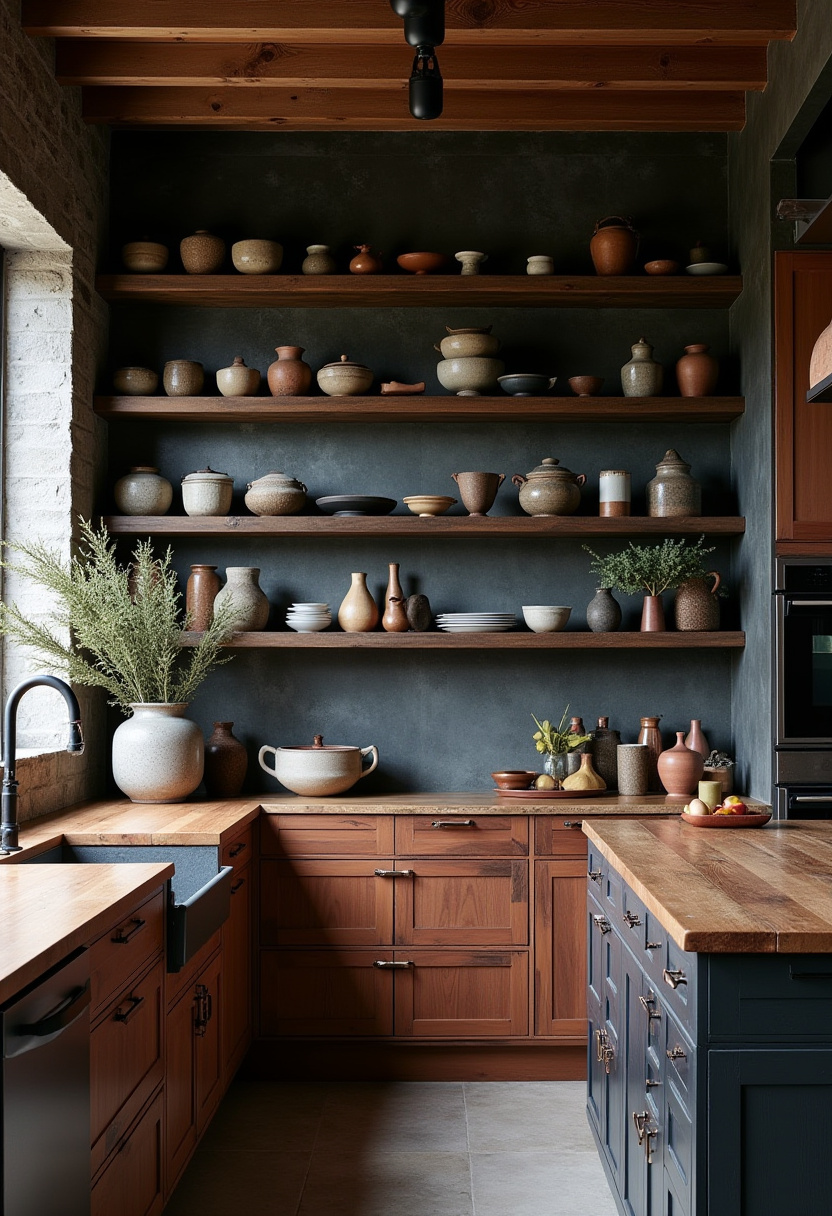
This wabi sabi kitchen showcases industrial style with a focus on charcoal and copper tones. Salvaged metal shelving and handcrafted ceramic containers create a striking contrast against distressed wooden surfaces.
Dramatic side lighting enhances the textures, creating a dynamic and inviting atmosphere inspired by Kelly Wearstler.
The combination of industrial and natural elements in this kitchen fosters a sense of warmth and character. Each piece tells a story, contributing to the overall identity of the space.
This kitchen is perfect for those who appreciate the beauty of raw materials and the artistry of craftsmanship, making it a unique setting for culinary adventures.
- Incorporate salvaged metals for an industrial vibe.
- Add handcrafted ceramics for authenticity.
- Utilize distressed wood for character and warmth.
- Emphasize dramatic lighting to highlight textures.
15. Moroccan Dreamscape
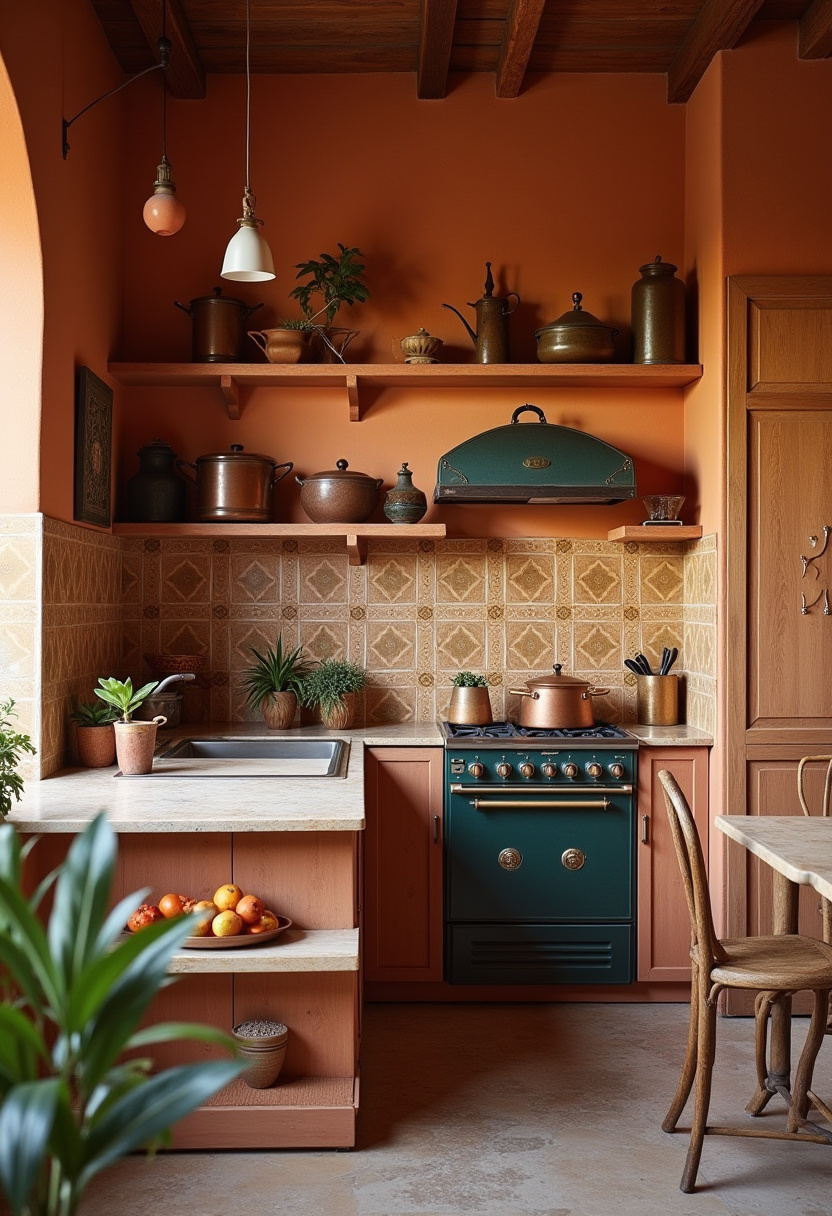
This wabi sabi kitchen transports you to a Moroccan oasis with its desert dusk palette. Hand-painted ceramic tiles and aged copper cookware create a vibrant yet earthy atmosphere, while weathered wooden surfaces add warmth and authenticity.
Warm golden hour lighting fills the space, enhancing the rich textures and inviting you to linger, inspired by India Mahdavi.
The combination of colors and materials in this kitchen evokes a sense of exotic charm and allure. This space encourages culinary exploration and shared moments, celebrating the joy of cooking and dining together.
The overall mood is one of warmth and hospitality, making it the perfect gathering spot for family and friends.
- Incorporate hand-painted tiles for visual interest.
- Add aged copper cookware for authenticity.
- Utilize weathered wood for warmth and character.
- Emphasize warm lighting to enhance the inviting atmosphere.
16. Scandinavian Simplicity
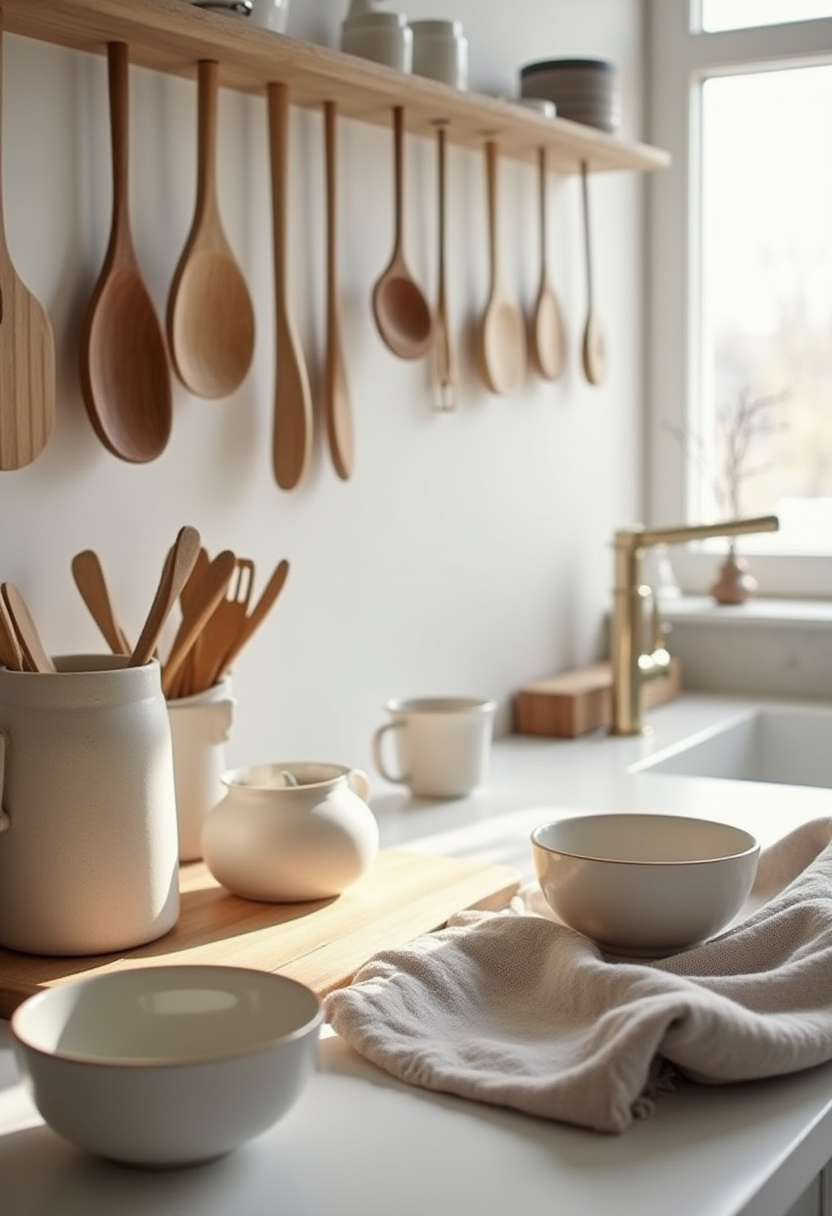
This wabi sabi kitchen embodies Scandinavian style with a focus on nordic neutrals. Featuring minimalist wooden utensils and hand-thrown ceramic bowls, this space is a celebration of simplicity and functionality.
Soft linen textiles add warmth, while gentle morning light creates a tranquil ambiance inspired by Piet Mondrian.
The serene color palette and organic forms in this kitchen foster a sense of calm and clarity, allowing for moments of reflection amidst the daily hustle. This space is perfect for those who appreciate the beauty of minimalism and the artistry of handcrafted elements.
- Utilize a neutral color palette for a tranquil effect.
- Incorporate hand-thrown ceramics for authenticity.
- Add minimalist wooden utensils for functionality.
- Emphasize natural light to enhance the serene atmosphere.
17. Coastal Retreat

Step into a wabi sabi kitchen that captures the essence of coastal living with soft blues and sandy beiges. Driftwood shelving and hand-glazed ceramic tiles create a harmonious blend of textures, while weathered maritime accessories add character and charm.
Diffused natural light fills the space, inviting you to relax and unwind, inspired by Renzo Piano.
The soothing color palette and organic forms in this kitchen evoke a sense of tranquility and ease, making it the perfect gathering spot for family and friends. This space encourages culinary exploration and shared moments, celebrating the joy of cooking and dining together.
The overall mood is one of effortless elegance, allowing for a seamless transition between indoor and outdoor living.
- Incorporate driftwood for a coastal touch.
- Use hand-glazed tiles for unique visual interest.
- Add maritime accessories for character and charm.
- Maximize natural light for an airy, open feel.
18. Art Nouveau Inspiration

This wabi sabi kitchen embodies the elegance of art nouveau style with soft greens and golds. Hand-carved wooden details and ceramic art pieces create a visually striking environment, while organic curved surfaces invite a sense of flow and harmony.
Soft morning light fills the space, enhancing the beauty of craftsmanship inspired by Jean-Louis Deniot.
The combination of colors and textures in this kitchen fosters a sense of tranquility and inspiration. This space encourages culinary creativity and connection, making it an ideal setting for shared meals and heartfelt conversations.
The overall mood is one of refined elegance, inviting you to embrace the artistry of cooking.
- Incorporate hand-carved details for authenticity.
- Use ceramic art pieces for visual interest.
- Add organic curves for a sense of flow.
- Emphasize soft lighting to enhance the serene atmosphere.
19. Biophilic Beauty
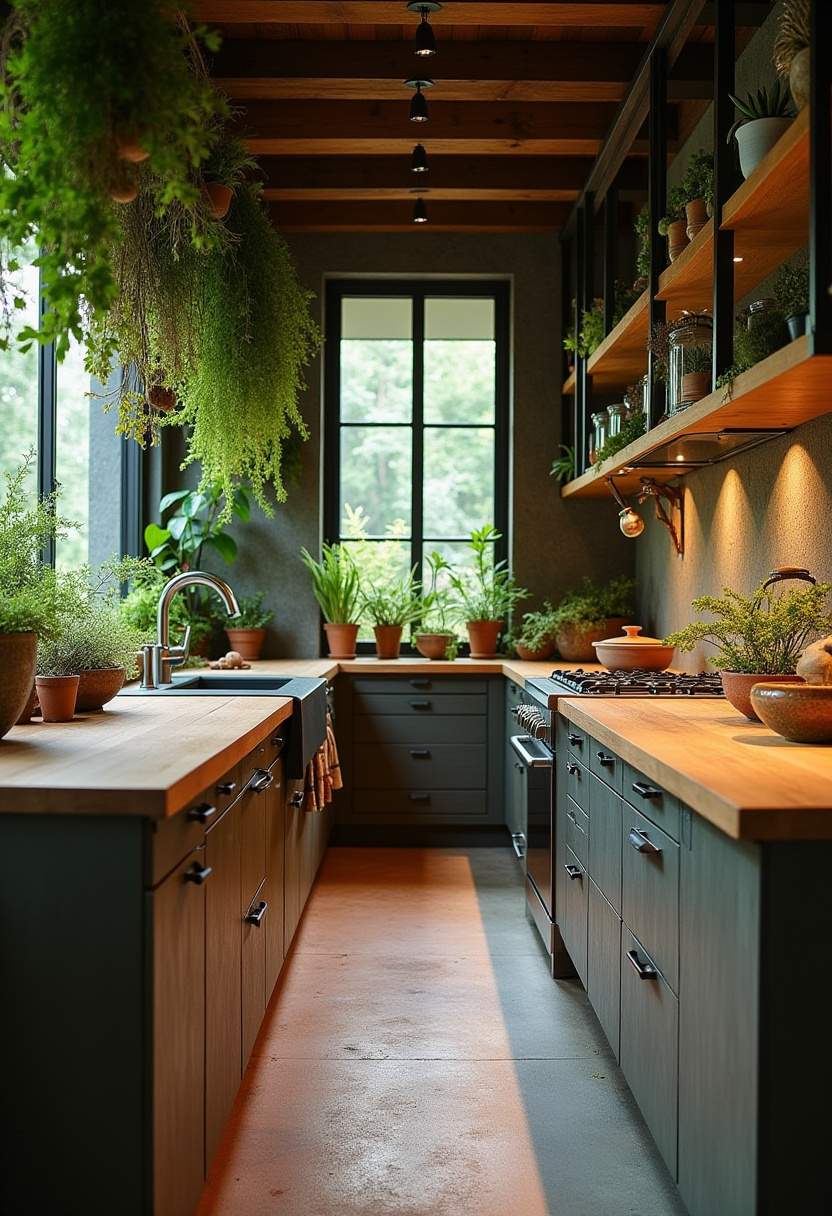
Step into a wabi sabi kitchen that celebrates biophilic design with an urban jungle palette. Featuring a living wall and recycled wooden countertops, this space embodies the principles of sustainability and wellness.
A hand-thrown ceramic sink serves as a functional centerpiece, while natural light pours in through large windows, creating a serene atmosphere inspired by Tadao Ando.
This kitchen fosters a connection with nature, encouraging healthy living and culinary creativity. The vibrant greens of the living wall infuse the area with life, making it a perfect space for culinary exploration and shared moments.
The overall mood is one of vitality and inspiration, inviting you to embrace the beauty of nature in your daily routine.
- Add a living wall for freshness and utility.
- Choose recycled materials for a sustainable approach.
- Incorporate plants for a natural feel and improved air quality.
- Utilize natural light to enhance the connection with nature.
20. Traditional Japanese Tranquility
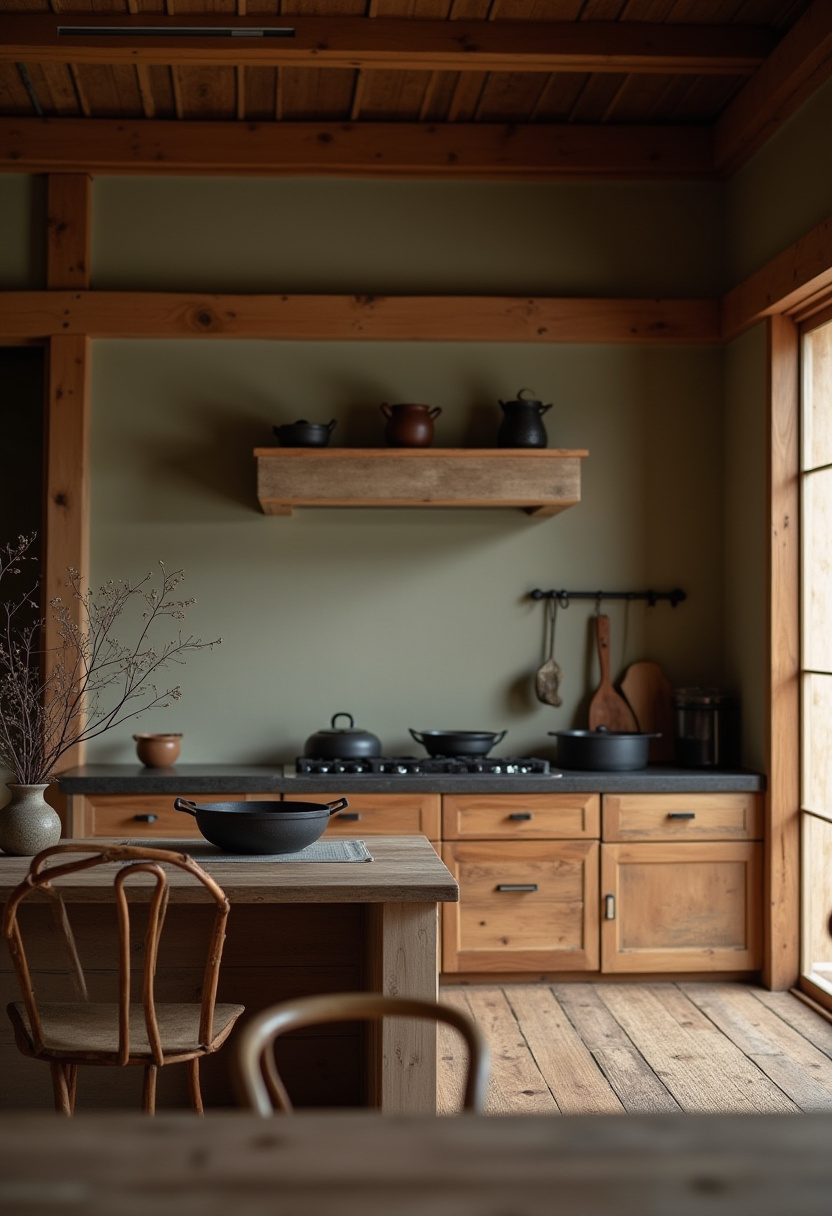
This wabi sabi kitchen embraces traditional Japanese style with muted earth tones and natural materials. Bamboo elements and hand-forged iron cookware add authenticity, while aged wooden surfaces contribute to the rustic charm.
Soft diffused light creates a serene atmosphere, allowing the space to breathe with life and purpose, inspired by Vincent Van Duysen.
The balance of materials in this kitchen fosters a sense of tranquility, creating a perfect setting for mindful cooking and dining. This area encourages connection to nature and the beauty of simplicity, making it an idyllic retreat for culinary exploration.
The overall mood is one of quiet elegance, ideal for those seeking a peaceful sanctuary.
- Use bamboo elements for a touch of nature.
- Incorporate hand-forged cookware for authenticity.
- Add aged wooden surfaces for warmth and character.
- Emphasize soft lighting to create an inviting ambiance.
21. Mediterranean Paradise
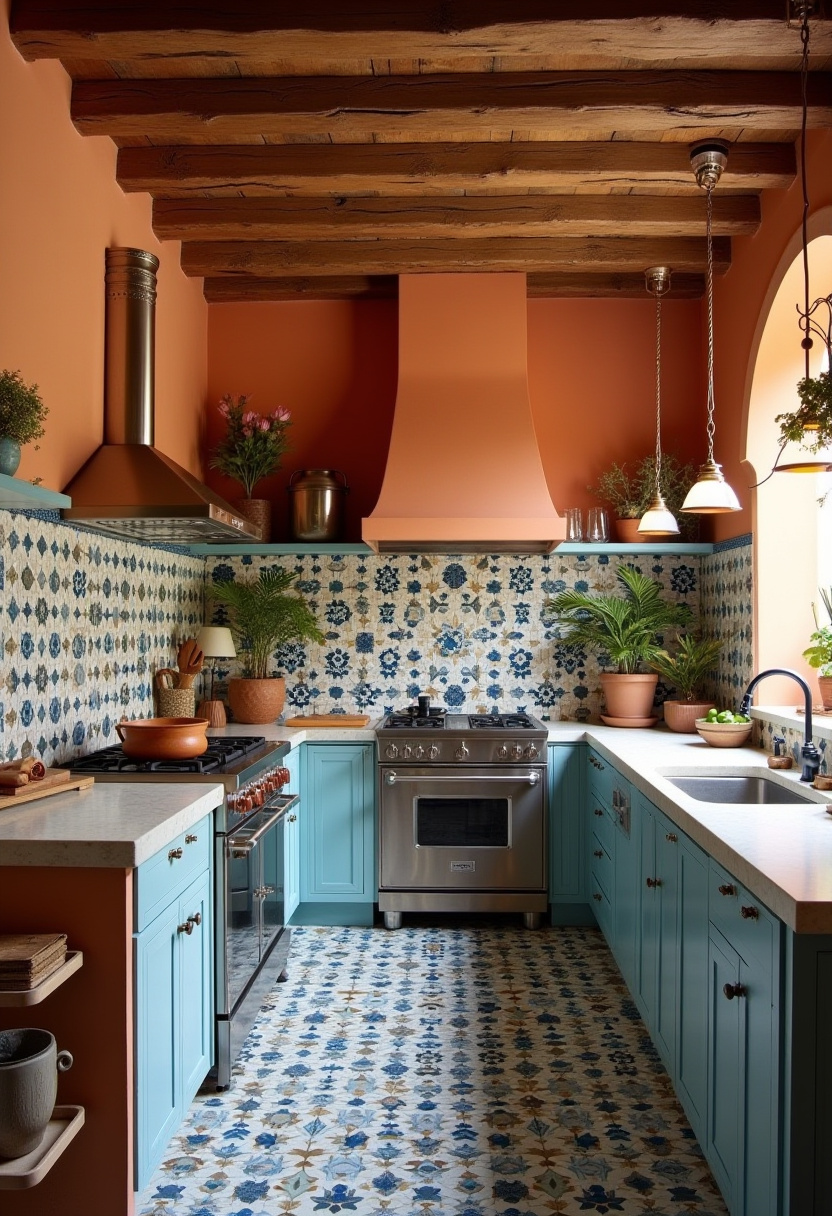
This wabi sabi kitchen captures the essence of Mediterranean charm with its terracotta and azure palette. Hand-painted ceramic tiles and weathered wooden beams create a warm and inviting atmosphere, while copper accents add a touch of elegance.
Warm golden hour lighting fills the space, enhancing the rustic charm and creating a cozy ambiance, inspired by Kelly Wearstler.
The rich color palette and handcrafted elements in this kitchen evoke a sense of warmth and hospitality, making it the perfect gathering spot for family and friends. This space encourages culinary exploration and shared moments, celebrating the joy of cooking and dining together.
The overall mood is one of effortless charm, inviting you to linger and enjoy.
- Incorporate hand-painted tiles for visual interest.
- Add weathered wooden beams for rustic charm.
- Choose copper accents for a touch of elegance.
- Utilize warm lighting to enhance the inviting atmosphere.
22. Craftsman Elegance
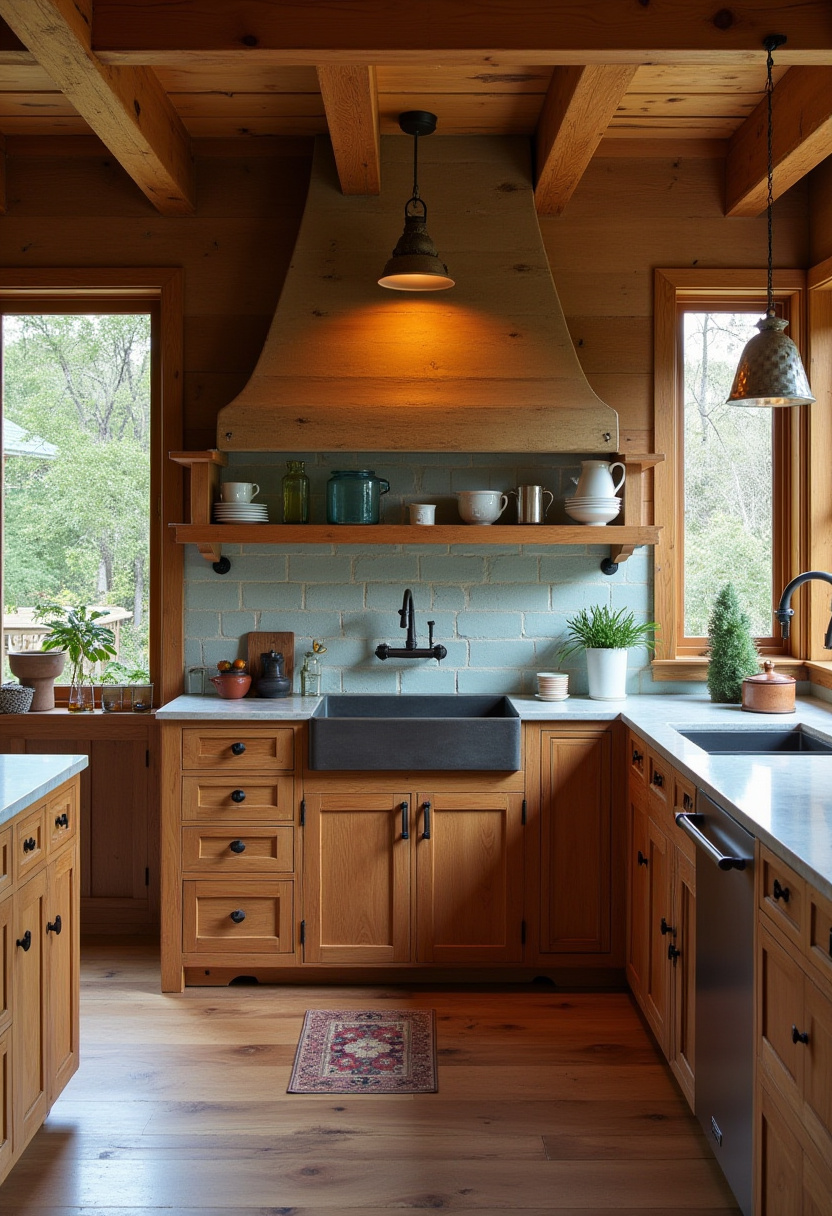
This wabi sabi kitchen showcases craftsman style with a focus on rustic retreat aesthetics. Featuring a hand-hammered metal sink that serves as a stunning centerpiece, reclaimed wood cabinetry offers warmth and character.
Artisan ceramic tiles add visual interest, while soft natural light filters through stained glass, creating a magical ambiance inspired by Frank Lloyd Wright.
The attention to detail in this kitchen reflects the beauty of craftsmanship, where each element is thoughtfully curated to create a harmonious whole. The inviting atmosphere encourages creativity and connection, making it a welcoming space for culinary adventures and gatherings.
This kitchen embodies the spirit of craftsmanship, celebrating the artistry of the everyday.
- Use hand-hammered metals for unique focal points.
- Incorporate reclaimed wood for warmth and history.
- Add artisan tiles for visual interest and character.
- Utilize stained glass to enhance natural light and ambiance.
23. Nordic Inspired Serenity
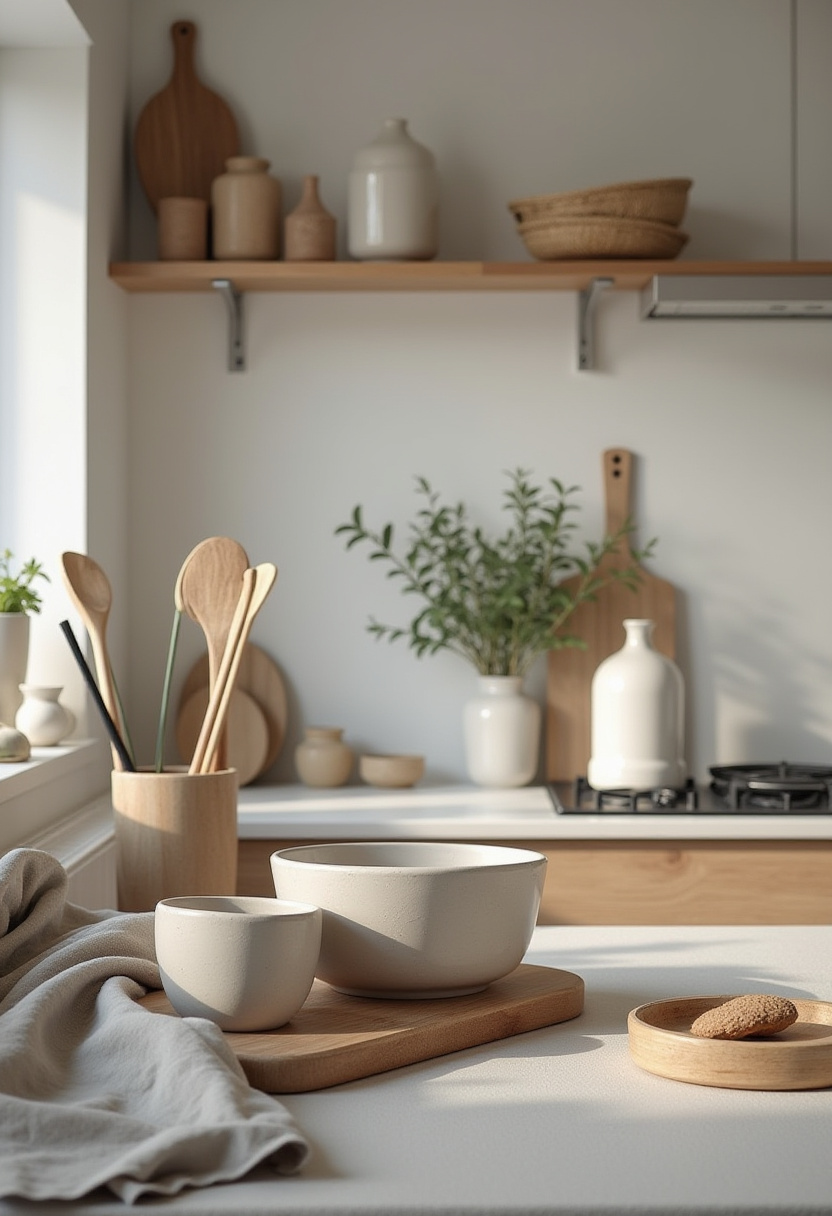
This wabi sabi kitchen reflects Nordic style with a focus on soft grays and natural woods. Featuring minimalist ceramic bowls and hand-carved wooden utensils, this space is a celebration of simplicity and functionality.
Gentle morning light pours in, creating a soothing atmosphere inspired by Piet Mondrian.
The serene color palette and organic forms in this kitchen foster a sense of calm and clarity, allowing for moments of reflection amidst the daily hustle. This space is perfect for those who appreciate the beauty of minimalism and the artistry of handcrafted elements.
- Utilize soft gray tones for a calming environment.
- Incorporate hand-carved wooden utensils for authenticity.
- Add minimalist ceramic bowls for a clean aesthetic.
- Emphasize natural light for an airy feel.
24. Tropical Escape
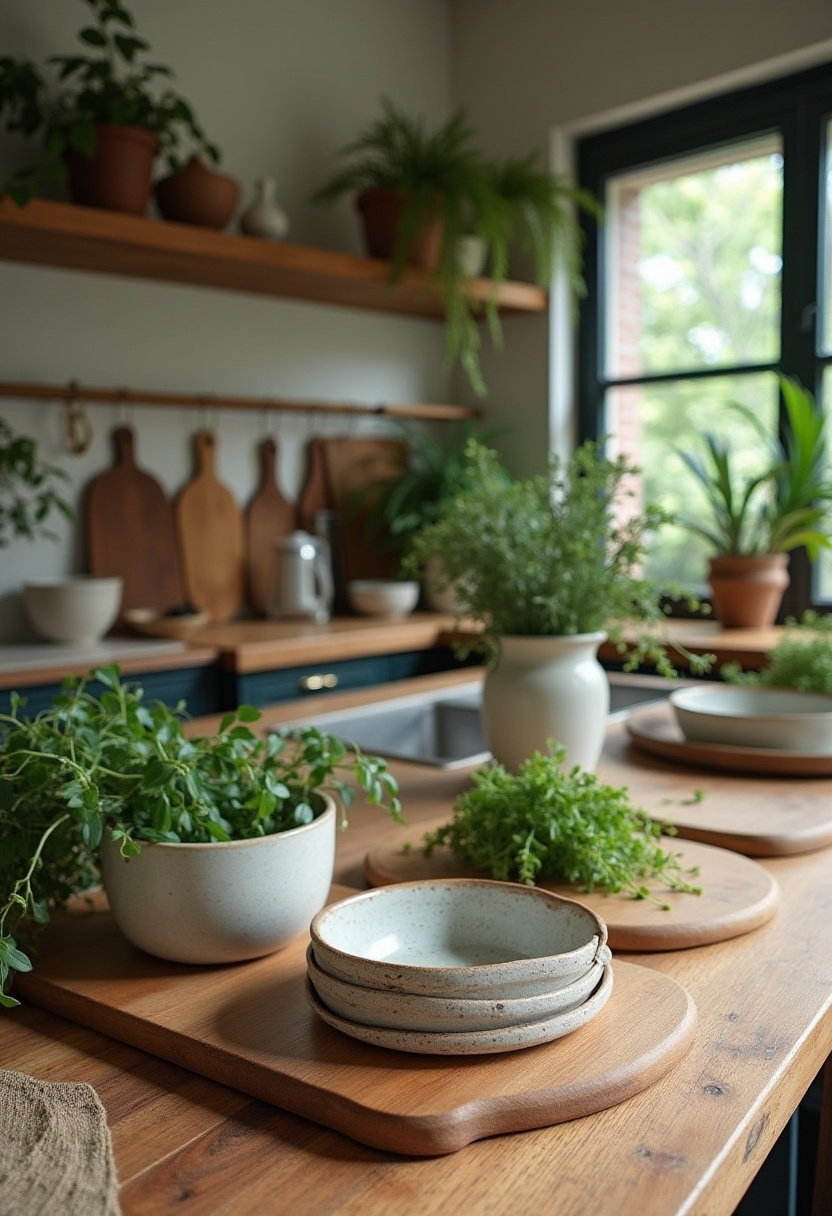
This wabi sabi kitchen transports you to a tropical paradise with its urban jungle palette. Featuring hand-thrown ceramic plates and bamboo cutting boards, this space embodies the principles of sustainability and wellness.
A living herb wall adds freshness and vitality, while soft diffused light filters through the tropical plants, creating a serene atmosphere inspired by Justina Blakeney.
This kitchen is a celebration of vibrant colors and natural textures, fostering a sense of connection to the outdoors. The lush greenery and handcrafted elements encourage culinary creativity and healthy living, making it an ideal space for culinary exploration.
The overall mood is one of vitality and inspiration, inviting you to embrace the beauty of nature in your daily routine.
- Incorporate a living herb wall for freshness and utility.
- Use hand-thrown ceramics for a personal touch.
- Add bamboo elements for a tropical vibe.
- Utilize soft lighting to create a serene atmosphere.
25. Industrial Sophistication
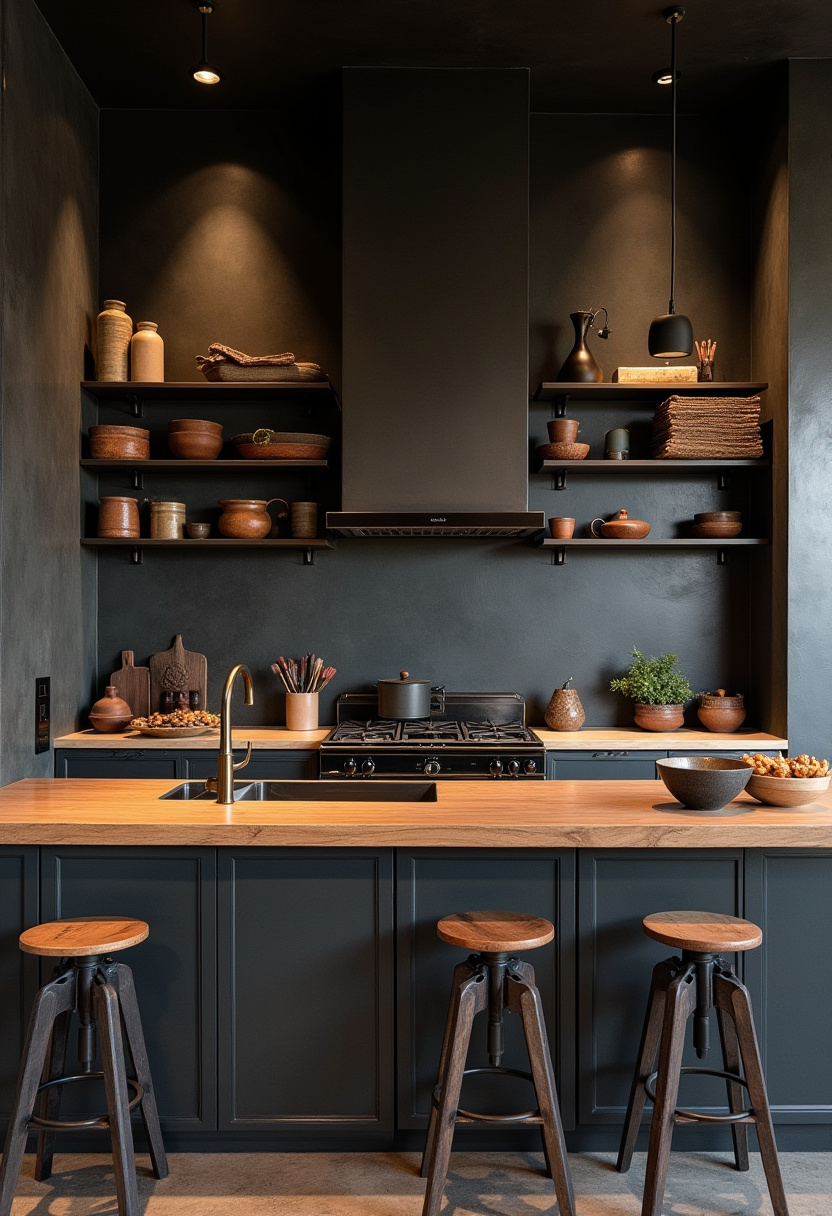
This wabi sabi kitchen showcases industrial style with a focus on charcoal and copper tones. Salvaged metal shelving and handcrafted ceramic containers create a striking contrast against distressed wooden surfaces.
Dramatic side lighting enhances the textures, creating a dynamic and inviting atmosphere inspired by Le Corbusier.
The combination of industrial and natural elements in this kitchen fosters a sense of warmth and character. Each piece tells a story, contributing to the overall identity of the space.
This kitchen is perfect for those who appreciate the beauty of raw materials and the artistry of craftsmanship, making it a unique setting for culinary adventures.
- Incorporate salvaged metals for an industrial vibe.
- Add handcrafted ceramics for authenticity.
- Utilize distressed wood for character and warmth.
- Emphasize dramatic lighting to highlight textures.
26. Moroccan Oasis

This wabi sabi kitchen transports you to a Moroccan oasis with its desert dusk palette. Hand-painted ceramic tiles and aged copper cookware create a vibrant yet earthy atmosphere, while weathered wooden surfaces add warmth and authenticity.
Warm golden hour lighting fills the space, enhancing the rich textures and creating a cozy ambiance, inspired by India Mahdavi.
The combination of colors and materials in this kitchen evokes a sense of exotic charm and allure. This space encourages culinary exploration and shared moments, celebrating the joy of cooking and dining together.
The overall mood is one of warmth and hospitality, making it the perfect gathering spot for family and friends.
- Incorporate hand-painted tiles for visual interest.
- Add aged copper cookware for authenticity.
- Utilize weathered wood for warmth and character.
- Emphasize warm lighting to enhance the inviting atmosphere.
27. Art Nouveau Elegance
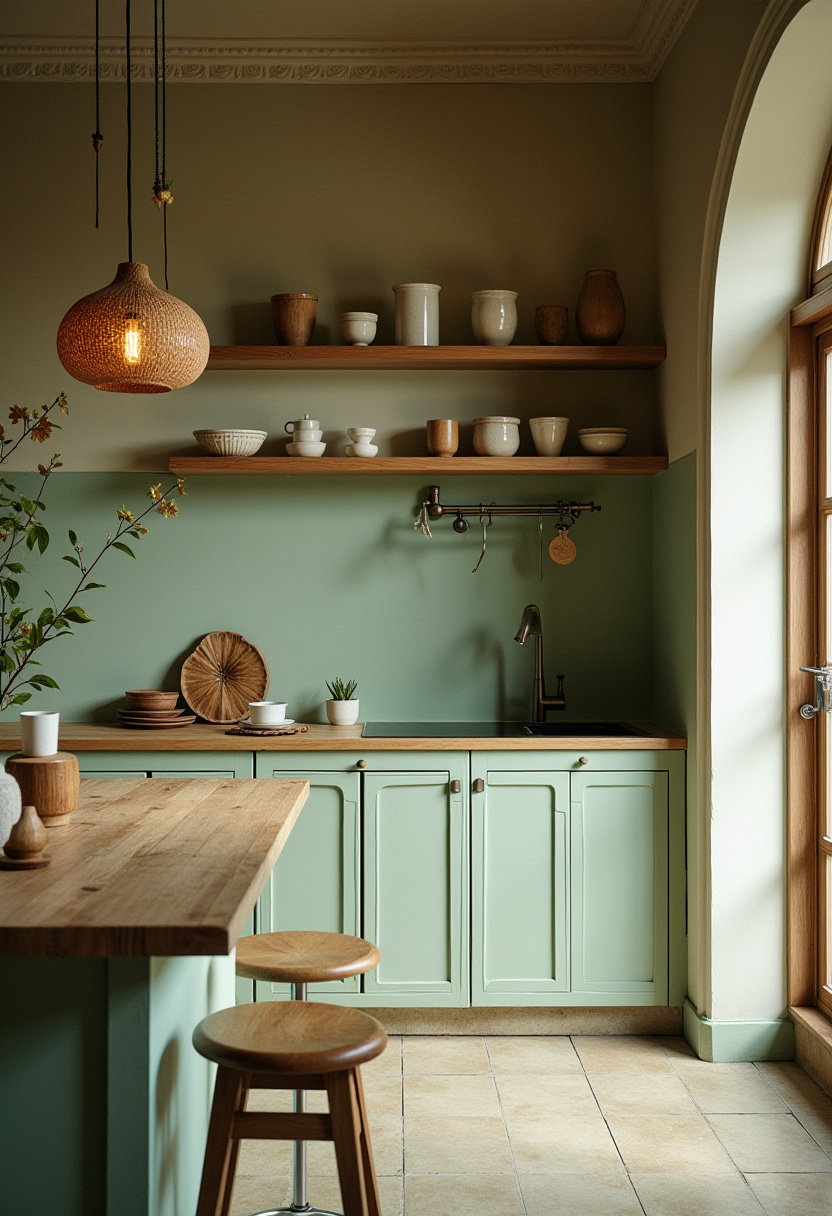
This wabi sabi kitchen embodies the elegance of art nouveau style with soft greens and golds. Hand-carved wooden details and ceramic art pieces create a visually striking environment, while organic curved surfaces invite a sense of flow and harmony.
Soft morning light fills the space, enhancing the beauty of craftsmanship inspired by Jean-Louis Deniot.
The combination of colors and textures in this kitchen fosters a sense of tranquility and inspiration. This space encourages culinary creativity and connection, making it an ideal setting for shared meals and heartfelt conversations.
The overall mood is one of refined elegance, inviting you to embrace the artistry of cooking.
- Incorporate hand-carved details for authenticity.
- Use ceramic art pieces for visual interest.
- Add organic curves for a sense of flow.
- Emphasize soft lighting to enhance the serene atmosphere.
28. Coastal Haven
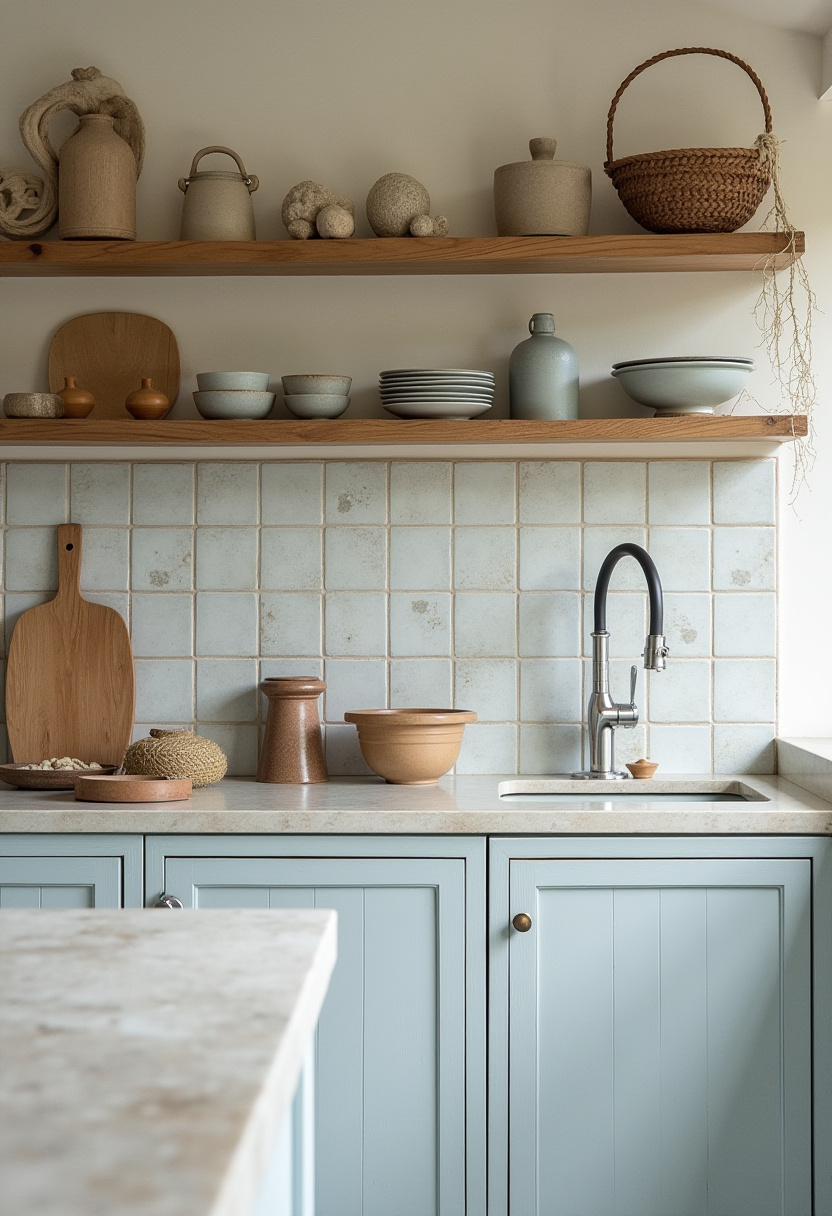
Step into a wabi sabi kitchen that captures the essence of coastal living with soft blues and sandy beiges. Driftwood shelving and hand-glazed ceramic tiles create a harmonious blend of textures, while weathered maritime accessories add character and charm.
Diffused natural light fills the space, inviting you to relax and unwind, inspired by Renzo Piano.
The soothing color palette and organic forms in this kitchen evoke a sense of tranquility and ease, making it the perfect gathering spot for family and friends. This space encourages culinary exploration and shared moments, celebrating the joy of cooking and dining together.
The overall mood is one of effortless elegance, allowing for a seamless transition between indoor and outdoor living.
- Incorporate driftwood for a coastal touch.
- Use hand-glazed tiles for unique visual interest.
- Add maritime accessories for character and charm.
- Maximize natural light for an airy, open feel.
29. Biophilic Inspiration
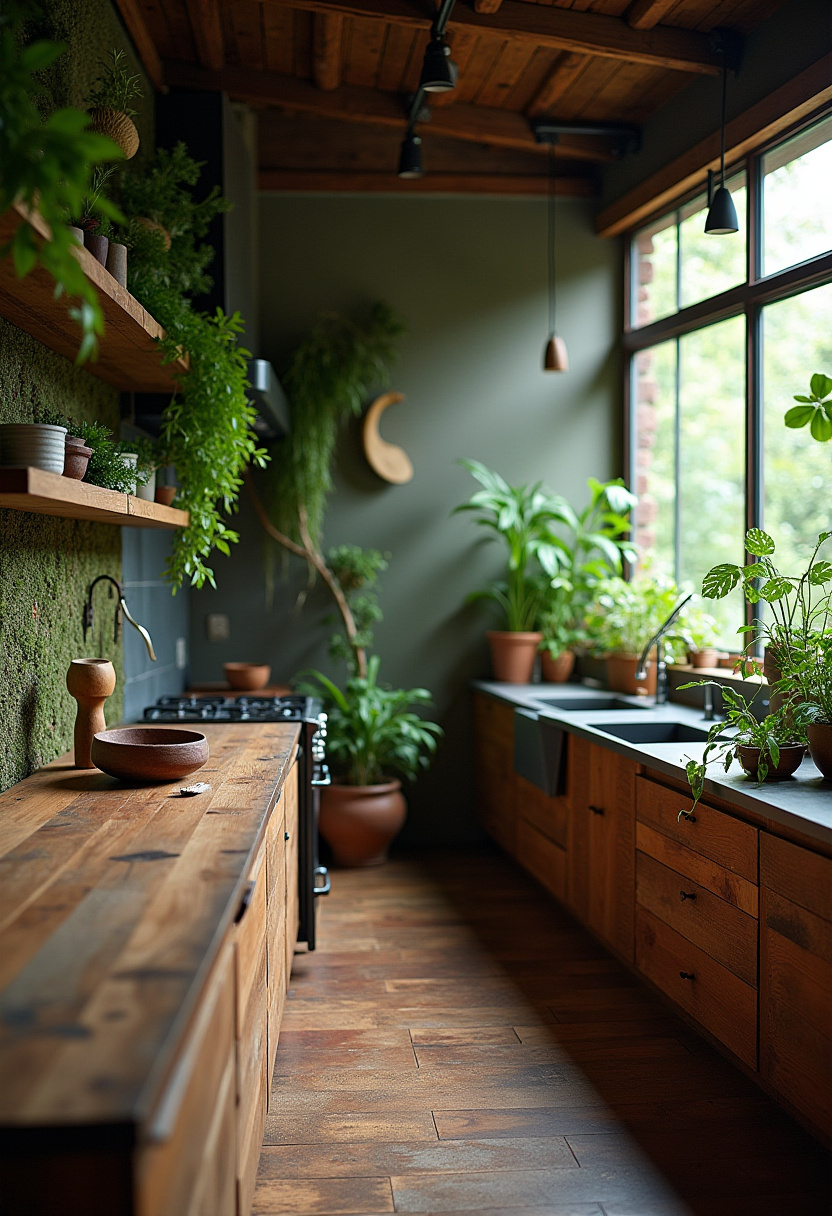
This wabi sabi kitchen celebrates biophilic design with an urban jungle palette. Featuring a living plant wall and recycled wooden countertops, this space embodies the principles of sustainability and wellness.
A hand-thrown ceramic sink serves as a functional centerpiece, while natural light pours in through large windows, creating a serene atmosphere inspired by Vincent Van Duysen.
This kitchen fosters a connection with nature, encouraging healthy living and culinary creativity. The vibrant greens of the living wall infuse the area with life, making it a perfect space for culinary exploration and shared moments.
The overall mood is one of vitality and inspiration, inviting you to embrace the beauty of nature in your daily routine.
- Add a living plant wall for freshness and utility.
- Choose recycled materials for a sustainable approach.
- Incorporate plants for a natural feel and improved air quality.
- Utilize natural light to enhance the connection with nature.
30. Traditional Japanese Essence

This wabi sabi kitchen embraces traditional Japanese style with muted earth tones and natural materials. Bamboo elements and hand-forged iron cookware add authenticity, while aged wooden surfaces contribute to the rustic charm.
Soft diffused light creates a serene atmosphere, allowing the space to breathe with life and purpose, inspired by Tadao Ando.
The balance of materials in this kitchen fosters a sense of tranquility, creating a perfect setting for mindful cooking and dining. This area encourages connection to nature and the beauty of simplicity, making it an idyllic retreat for culinary exploration.
The overall mood is one of quiet elegance, ideal for those seeking a peaceful sanctuary.
- Use bamboo elements for a touch of nature.
- Incorporate hand-forged cookware for authenticity.
- Add aged wooden surfaces for warmth and character.
- Emphasize soft lighting to create an inviting ambiance.
In conclusion, the wabi sabi kitchen embraces the beauty of imperfection, offering a diverse range of design concepts that cater to various tastes and lifestyles. From rustic charm to minimalist elegance, each design highlights the importance of natural materials, organic forms, and a serene atmosphere.
As you explore these ideas, remember that your kitchen should reflect your personality and values, encouraging you to create a space that feels authentic and inspiring. Embrace the beauty of imperfection, and let your wabi sabi kitchen become a sanctuary for culinary exploration and connection.

